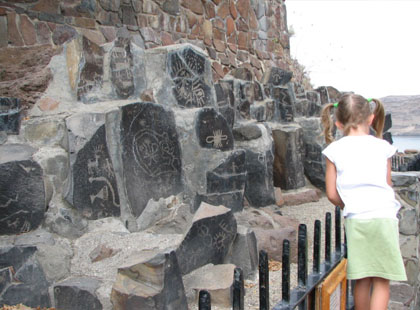Site Stewardship
What are Archaeological Sites?
Archaeological sites are the physical remains of past human activity. Wherever people have lived and worked, the land and water may contain evidence of their lives. The prehistoric ancestors of Washington's Indians lived here 12,000 years before the arrival of the first European colonists. They left behind the remains of camps, villages, quarries, and hunting and fishing sites, all scattered across Washington beneath the visible landscape. Traces of structures built since settlement such as the foundations of  19th-century gristmills, stone walls of deserted farmsteads, and abandoned cemeteries all contain valuable information about the lives of the people who lived before we did.
19th-century gristmills, stone walls of deserted farmsteads, and abandoned cemeteries all contain valuable information about the lives of the people who lived before we did.
These clues, tangible links to our past, are often invisible from the surface. Traces of earlier occupation may lie under parking lots, buildings, or plowed fields and are only discovered through archaeological survey. As such, archaeological sites scattered across the state represent a tangible link to our past. Because most sites in Washington are privately owned they will be preserved through the generosity of private landowners, or not at all.
All archaeological sites are fragile and irreplaceable; they cannot be rebuilt or remade. In Washington, archaeological sites are disappearing at an alarming rate, and unless landowners take positive steps to preserve and manage these properties, valuable pieces of history will be lost forever. It is important that we all actively participate in the preservation and management of Washington's archaeological heritage.
Through the Department of Archaeology and Historic Preservation (DAHP), landowners are encouraged to preserve, protect, and interpret significant archaeological resources on their property. State archaeologists can provide information about the probable location of archaeological sites and can advise and assist landowners in evaluating and developing alternatives to preserve archaeological sites.
Survey and Registration
Archaeological sites discovered through survey that meet certain criteria for significance and integrity can be listed in the National Register of Historic Places and the Washington Heritage Register, the nation’s and state’s lists of significant sites. Registration informs individuals and localities of important resources that they may wish to consider in private and community land use decisions.
Site Stewardship Plan
With the help of DAHP a site stewardship plan can be developed to provide specific guidance and recommendations to a landowner with archaeological sites on his or her property. The plan assists the landowner in preserving, protecting, and interpreting archaeological sites in his or her care. The success of the plan depends solely on the participation and commitment of landowners.
Archaeological Sites: Some DOs and DON’Ts
- Do keep records of artifacts found lying on the surface of your property.
- Do report sites discovered on your property to the Office of Archaeology and Historic Preservation. Your report will not trigger any land use decisions but will aid in scientific research and preservation planning.
- Do maintain your site in its natural condition and protect it from inadvertent destruction.
- Do learn more about your site and other nearby sites. Encourage scholarly research to interpret the prehistoric and historic assets of your property.
- Don't allow unqualified persons to "collect" or "dig" at your site. Report any unauthorized activities—"looting"—to the State Archaeologist and local police.
- Don't conduct any earth moving or construction in the immediate vicinity of your site.
Visiting an Archaeological Site - "Innocent Acts that can Cause Damage"
 Archaeological sites are fragile and nonrenewable. Proper etiquette is essential when visiting ancient sites. Appreciate the site and contemplate times long past, but please leave the site undisturbed for others to enjoy. Once damaged, the secrets an archaeological site can tell us, are lost forever.
Archaeological sites are fragile and nonrenewable. Proper etiquette is essential when visiting ancient sites. Appreciate the site and contemplate times long past, but please leave the site undisturbed for others to enjoy. Once damaged, the secrets an archaeological site can tell us, are lost forever.
Please take a few moments to read and review these following guidelines before you visit an archaeological site. As you approach an archaeological site, stop for a moment and think about how you can minimize the impact of your visit to the site.
- Stay back from any exposed edges, soils, or rock features.
- Do not step on artifacts.
- Stay on established trails and avoid creating new ones.
- Please do NOT remove or disturb anything. Strict laws prohibit the removal and theft of artifacts. If you do accidentally move something, put it back exactly where you found it.
- Avoid handling artifacts and the vegetation.
- If you are visiting a petroglyph or pictograph site take only pictures with your camera. Avoid touching, rubbing, tracing or chalking the surface. Such actions alter the surface of the image and can damage and alter the image over time.
- Children's natural curiosity and enthusiasm for exploring and collecting is great. Please teach your youngster about archaeological site etiquette.




